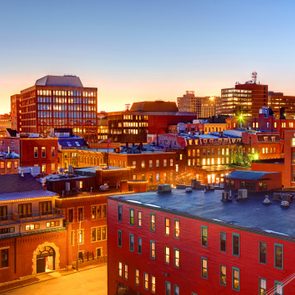Most retirees seek affordability, but for others, there's a place that has it all—if you have the cash

Beware: This Is the Most Expensive Place to Retire in the U.S. in 2025

The most expensive place to retire in the United States doesn’t make the list of most expensive cities, but it’s in the same region as No. 3, and it won’t take much to figure out which region that is.
The city, as determined by GOBankingRates, is the one where retirees need the deepest pockets, located in the second most expensive state in the U.S., and the most expensive in the contiguous U.S. The most expensive place to retire in the U.S. might not even be on your radar—housing supply is low, and when homes do come up for sale, they are out of financial reach for most Americans, especially retirees.
Now, let’s take a closer look at GOBankingRates’s report and how it compiled its list of the 30 most expensive retirement towns in the U.S., as well as which city nabbed the No. 1 spot.
Get Reader’s Digest’s Read Up newsletter for more news, wellness, travel, tech, cleaning, humor and fun facts all week long.
How was the most expensive town determined?
GOBankingRates included towns with populations of 25,000 or more with at least 25% of their year-round population aged 65 and over, based on the U.S. Census Bureau’s 2023 five-year American Community Survey.
In addition, GOBankingRates considered cost-of-living indexes by factoring in things like average expenditure costs for retirees, mortgage and rent costs, and the total cost of necessities for the average retired homeowner.
In addition, GOBankingRates examined the national average 30-year fixed mortgage rate as of June 26, 2025, which was 6.77% as sourced from the Federal Reserve Economic Data. It obtained data from Sperling’s BestPlaces for grocery, health-care, utility and transportation costs, using the 2023 Bureau of Labor Statistics Consumer Expenditure Survey for retired households.
Finally, overall expenses were combined with mortgage and rent costs to find the total cost of necessities for homeowners and renters. GOBankingRates ranked the cities from highest to lowest total cost of necessities for retired homeowners. According to GOBankingRates, all data is current as of June 27, 2025.
Which town is the most expensive to retire in?

That honor goes to Saratoga, California, which ranked as the most expensive town to retire in and where 26% of the population is 65 or older. If you’re looking at lower-cost retirement, consider one of these states with affordable retirement costs.
Saratoga is adjacent to San Jose, in the area south of the San Francisco Bay, known as the South Bay, which is often considered the heart of Silicon Valley. The South Bay is directly south of another affluent region known as The Peninsula, which extends roughly from San Francisco to Palo Alto and is home to numerous tech companies and Stanford University. The South Bay has a more suburban feel, with family-friendly neighborhoods and amenities.
The U.S. Census Bureau’s page on Saratoga estimates the total population at 30,486 as of July 1, 2025. Recent Zillow data indicate that the average—yes, the average—home price in Saratoga is $4,024,743, a 4.4% increase over the past year. (For some context, the average home price in the U.S. is $503,800.) GOBankingRates reports that the expenses don’t end there. The average annual cost of groceries is $6,165, the average annual cost of health care is $8,544, and the total annual cost of living for a homeowner is estimated to be $282,625.
This is all to say, expensive might be an slight understatement in Saratoga.
What makes Saratoga the most expensive town to retire in?
Saratoga is undeniably expensive, so not surprisingly, “not a lot of people are looking to move to Saratoga for their retirement,” says Howard Brown, a Coldwell Banker realtor based in the area. “People in that age group were already here.” Still, a quarter of Saratoga’s population is of retirement age, so they must be staying in this South Bay area for a reason. Let’s take a closer look at what makes Saratoga great, despite the extremely high cost of living.
Top-dollar real estate
As mentioned, the average home price in Saratoga is over $4 million, but that’s if you can even find a house. “In any kind of market, inventory plays a part,” Brown says. “Saratoga has more buyers than available properties.”
Saratoga isn’t as expensive as other Bay Area towns, such as Atherton—where the median home price exceeds a staggering $8 million—but Brown shared a few listings with us, such as a $19.5 million property. Sure, it has six bedrooms, 11 bathrooms and amenities such as an elevator, golf simulator, nine fireplaces or fire pits and a swimming pool on over four acres, but even with the elevator, this isn’t the type of home retirees usually go for.
Based on the real estate costs, Saratoga is a place for top tech executives, venture capitalists and the like. Brown doesn’t mince words when he says, “Normal working people can’t afford to live in Saratoga.”
Rentals are scarce, and even a basic two-bedroom apartment costs at least $4,000 per month just for rent.
Overall safety
Saratoga is one of the safest places to live in the San Francisco Bay Area, and Saratoga is frequently listed as one of the safest cities in California. “The South Bay, for the most part, is pretty safe,” Brown says, and Saratoga is no exception. Saratoga residents are active in neighborhood watch groups, and the area has a low violent crime rate with zero murders. Though theft and property crimes exist, they are lower than the national average.
According to Saratoga City’s website, property crimes increased in 2021 and 2022 due to a rise in unoccupied homes following the end of the pandemic lockdown. The city’s website also features a public safety page, and given the high fire risk in this area, precautions are in place to keep people and property safe through an emergency alert program and an emergency response team.
The town backs up to many open spaces, and wildlife, including coyotes, are in the area, but they don’t pose a huge danger.
Abundant outdoor recreation and nature opportunities
For many younger, fit retirees, access to nature is essential because they finally have time to take those long leisurely walks, hikes and bike rides they’ve been craving. Many Saratoga neighborhoods are adjacent to trails and open-space areas, making daily hikes a cinch. The Bay Area is an embarrassment of riches when it comes to outdoor opportunities, offering everything from activities like kayaking and road biking to more leisurely pursuits like beachcombing and wine tasting, all within a couple of hours.
Proximity to Silicon Valley
While proximity to some of the highest-paying jobs in the country is a plus for working adults, there are benefits for retirees too. The group Successful Aging Solutions & Community Consulting (SASCC) has a program called Senior Guided Pathways, which works to “make education more accessible, meaningful and impactful for adults aged 50 and over.”
Most people who spend their lives as entrepreneurs and dealmakers don’t just turn off their brains when they enter retirement, and SASCC helps keep seniors active in their community through partnerships with local businesses, nonprofits and community organizations to give seniors intellectual outlets through a variety of roles.
A wealth of cultural activities
“The weather makes it easy to be outside,” Brown shares. “There are all sorts of concerts and other events going on pretty much year-round.” The McAfee Performing Arts and Lecture Center is located in Saratoga—at the high school!—and has a 500-plus seating capacity. Attendees love the sound system, the acoustics and the range of performances, which extend beyond student shows to include stand-up comedy, symphonies, films and more. The Saratoga Civic Center is also in town, offering plays, musicals and other performances that visitors love, with one saying, “There are no ‘bad’ seats in the house.”
This is just in Saratoga itself, but the cultural opportunities around the Bay Area are vast and diverse, to put it mildly.
Exemplary health care
It’s no secret that San Francisco and the surrounding areas offer exemplary health-care facilities. Kaiser Permanente has locations in Saratoga as well as nearby Campbell, and there’s a larger medical center in Santa Clara. There’s no shortage of hospitals in the area, and for more complex medical situations, Stanford Medicine—renowned for its pioneering work in the medical world—leaves Saratoga residents in more-than-capable hands.
Additionally, there are several assisted-living communities located in Saratoga, with many more in nearby towns. The catch, of course, is that these top-notch facilities also come at a high cost.
What other towns are in the top 10 most expensive towns to retire in?
After Saratoga, the remaining towns rounding out the top 10 most expensive retirement areas are mainly located in California, but Arizona, Florida and Massachusetts also make a showing.
2. Rancho Palos Verdes, California
3. Walnut Creek, California
4. Cerritos, California
5. Palm Springs, California
6. Scottsdale, Arizona
7. La Quinta, California
8. Gloucester, Massachusetts
9. Palm Beach Gardens, Florida
10. Barnstable Town, Massachusetts
RELATED:
- New Report: This Is the Happiest State for Retirees
- These Are the Most and Least Stressed States in America—Which May Explain a Lot About How You’re Feeling Right Now!
- New Report: This Is the Most Welcoming City in the U.S.
About the experts
|
Why trust us
At Reader’s Digest, we’re committed to producing high-quality content by writers with expertise and experience in their field in consultation with relevant, qualified experts. We rely on reputable primary sources, including government and professional organizations and academic institutions as well as our writers’ personal experiences where appropriate. We verify all facts and data, back them with credible sourcing and revisit them over time to ensure they remain accurate and up to date. Read more about our team, our contributors and our editorial policies.
Sources:
- GOBankingRates: “30 Most Expensive Retirement Towns in America”
- Howard Brown, sales associate, Coldwell Banker, Los Gatos, CA; phone interview, July 2025
- U.S. Census Bureau: “QuickFacts Saratoga City, CA”
- Zillow: “Saratoga, CA Housing Market”
- Federal Reserve: “Median Sales Price of Houses Sold for the United States (MSPUS)”
- Saratoga, CA: “Public Safety”
- Successful Aging Solutions & Community Consulting: “Senior Guided Pathways”























